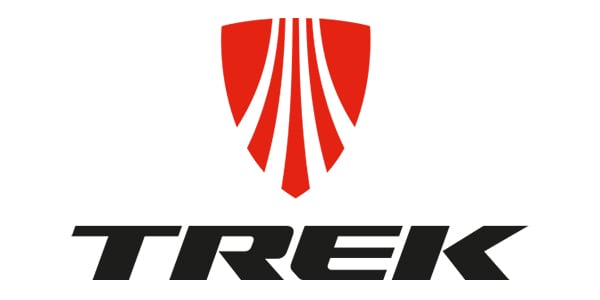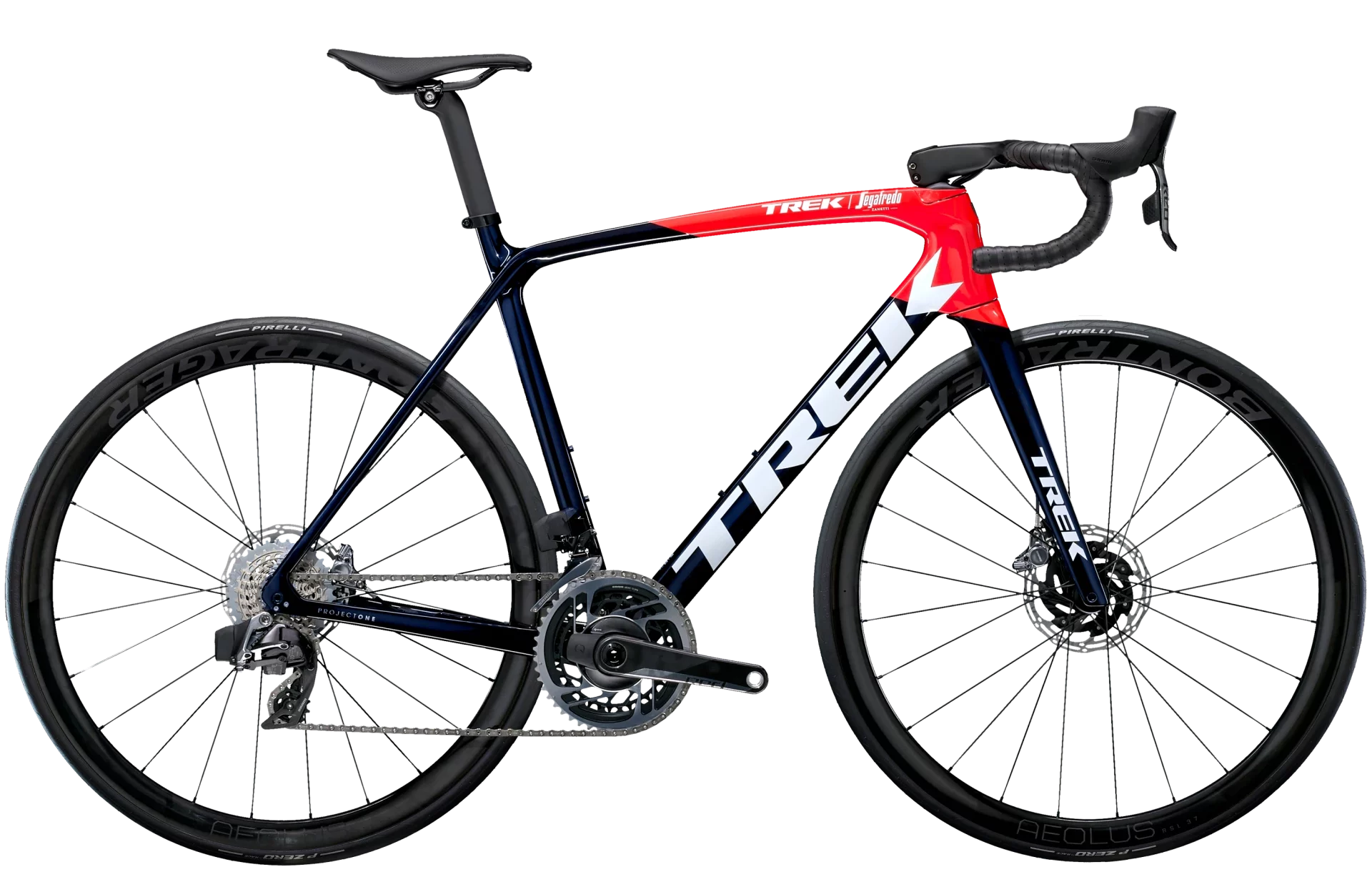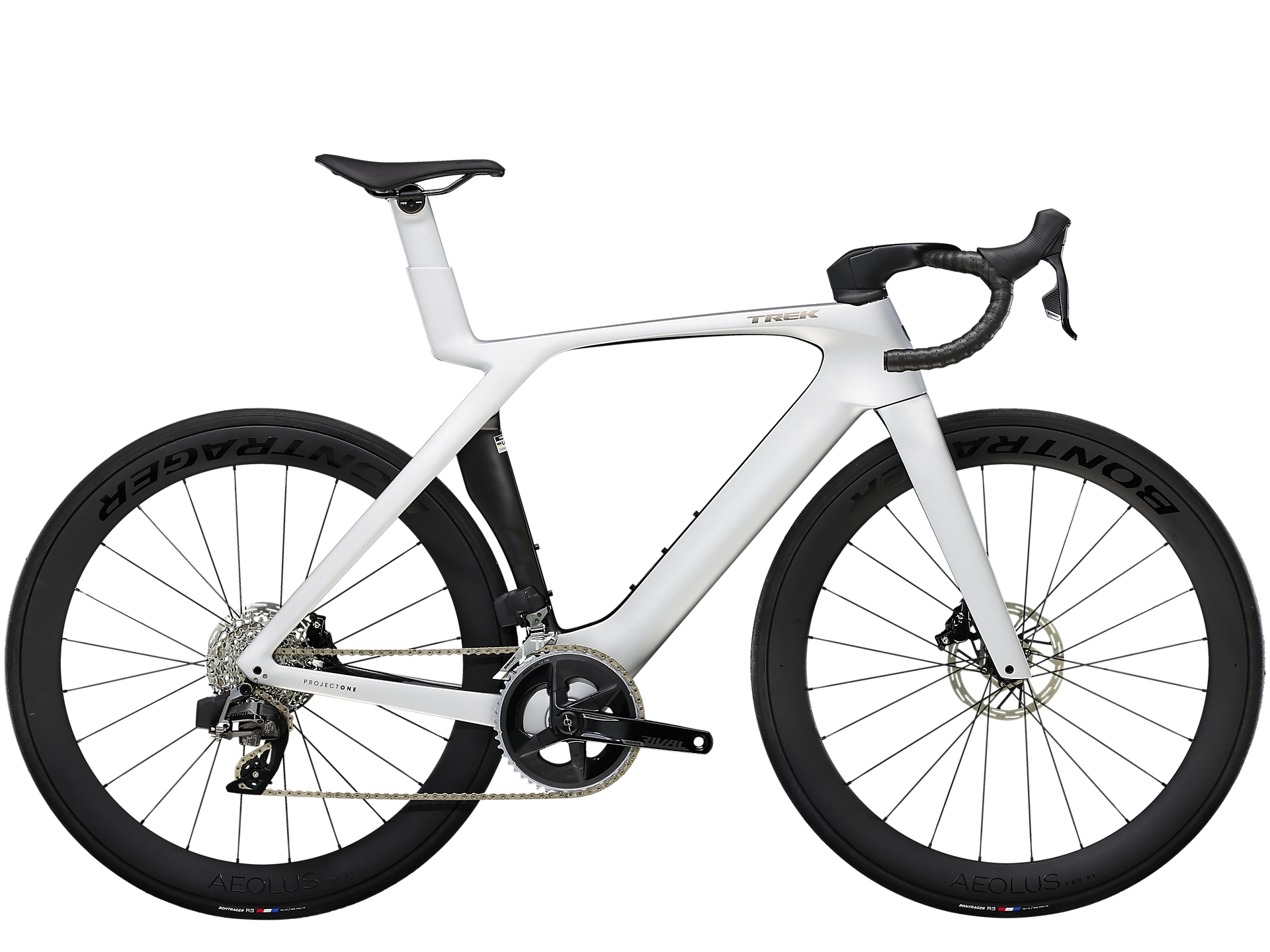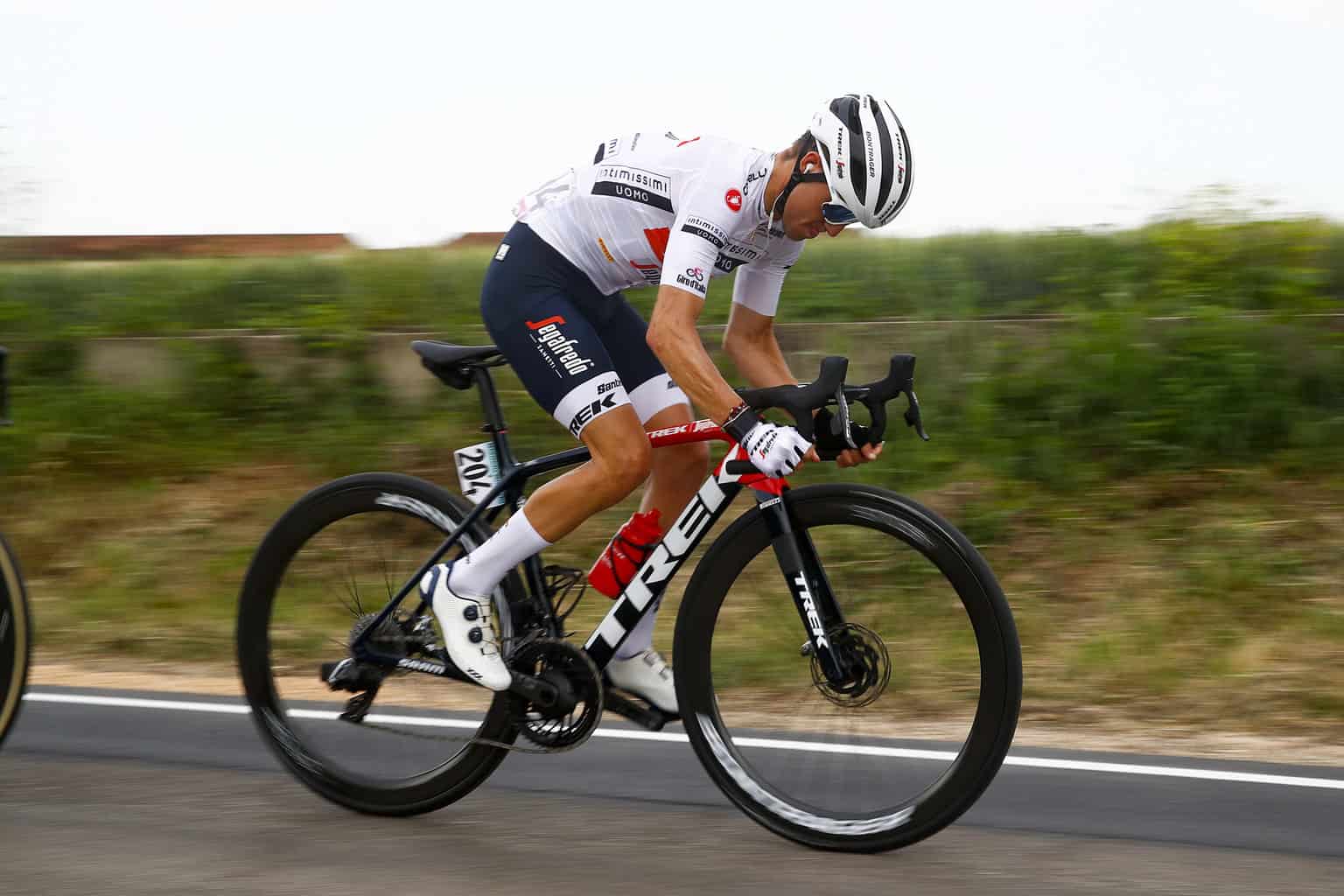
Trek bike names are easy to understand. There are three distinct models; Emonda, Madone, and Domane. Each model is designed to perform well in a particular type of ride.
The general rule of thumb below will give you a clear idea of what the bike is about, where it sits in the lineup, and how it’s specced.
- SLR models use the top-of-the-line OCLV 800 carbon.
- SL models use the mid-range, OCLV 500 carbon.
- ALR is for aluminum frames.
- Models ending with 9 use Shimano Dura-Ace Di2 or SRAM Red AXS groupsets.
- Models ending with 7 use Shimano Ultegra Di2 or SRAM Force AXS groupsets.
- Models ending with 6 use Shimano 105 Di2 or SRAM Rival AXS groupsets.
- Models ending with 5 use Shimano 105 R7000 groupset.
| Trek bike model | Type of Trek bike | Price range (USD) |
|---|---|---|
| Trek Emonda | Lightweight race bike | $4,999 to $13,199 |
| Trek Madone | Aero race bike | $5,199 to $13,199 |
| Trek Domane | Endurance bike | $4,699 to $13,199 |
Trek Emonda

The Trek Emonda is a lightweight bike for the high mountains.
The lightest Trek Emonda frame weighs less than 700g using Trek’s OCLV 800 carbon. This is the bike Richie Porte rode to his third place in the 2020 Tour de France.
The SLR is the lightest and most expensive atop the Trek Emonda models. There are six Emonda SLR options, specced electronic shifting groupsets from SRAM or Shimano.
Next in line is the SL, the mid-range, more budget-friendly option. It has the same frame design and geometry as the SLR but uses the OCLV 500 carbon instead. The groupset choices are Shimano Ultegra Di2, Shimano 105 Di2, SRAM Force AXS, or SRAM Rival AXS.
The Trek Emonda SLR and SL framesets are also available separately.
| Model | Frame material | Groupset | Wheelset | Retail price (USD) |
|---|---|---|---|---|
| Trek Emonda SLR 9 AXS | OCLV 800 carbon | SRAM Red eTap AXS | Bontrager Aeolus RSL 37 | $13,199 |
| Trek Emonda SLR 9 | OCLV 800 carbon | Shimano Dura-Ace Di2 (R9200) | Bontrager Aeolus RSL 37 | $12,749 |
| Trek Emonda SLR 7 AXS | OCLV 800 carbon | SRAM Force eTap AXS | Bontrager Aeolus Pro 37 | $9,699 |
| Trek Emonda SLR 7 | OCLV 800 carbon | Shimano Ultegra Di2 (R8100) | Bontrager Aeolus Pro 37 | $8,999 |
| Trek Emonda SLR 6 AXS | OCLV 800 carbon | SRAM Rival eTap AXS | Bontrager Aeolus Pro 37 | $8,399 |
| Trek Emonda SLR 6 | OCLV 800 carbon | Shimano 105 Di2 (R7100) | Bontrager Aeolus Pro 37 | $7,699 |
| Trek Emonda SL 7 AXS | OCLV 500 carbon | SRAM Force eTap AXS | Bontrager Aeolus Pro 37 | $6,699 |
| Trek Emonda SL 6 | OCLV 500 carbon | Shimano 105 Di2 (R7100) | Bontrager Aeolus Elite 35 | $4,999 |
Trek Emonda vs others
More reading : Trek Emonda Frame Geometry SRAM Red eTap AXS vs Shimano Dura-Ace (R9200) Groupset Comparison
Trek Madone

Dubbed the ultimate superbike, the Trek Madone is all about maximizing aerodynamics and speed.
Trek refreshed the Madone in June 2022, just before the Tour de France started. The new Trek Madone features a radical-looking seat tube with a big hole. The previous IsoSpeed system, which allows the seatpost to flex for extra comfort, is replaced by the IsoFlow Technology. According to Trek, the IsoFlow technology adds an aerodynamic advantage, reduces weight, and smooths the road ahead.
The range-topping Madone SLR is built on the Trek’s lightest OCLV 800 carbon, with a one-piece carbon handlebar. The Madone SL models are still based on the previous Madone frame design and use the OCLV 500 carbon.
The Madone SLR frameset is also available separately.
| Model | Frame material | Groupset | Wheelset | Retail price (USD) |
|---|---|---|---|---|
| Trek Madone SLR 9 AXS | OCLV 800 carbon | SRAM Red eTap AXS | Bontrager Aeolus RSL 51 | $13,199 |
| Trek Madone SLR 9 | OCLV 800 carbon | Shimano Dura-Ace Di2 (R9200) | Bontrager Aeolus RSL 51 | $12,749 |
| Trek Madone SLR 7 AXS | OCLV 800 carbon | SRAM Force eTap AXS | Bontrager Aeolus Pro 51 | $9,699 |
| Trek Madone SLR 7 | OCLV 800 carbon | Shimano Ultegra Di2 (R8100) | Bontrager Aeolus Pro 51 | $9,049 |
| Trek Madone SLR 6 AXS | OCLV 800 carbon | SRAM Rival eTap AXS | Bontrager Aeolus Pro 51 | $8,399 |
| Trek Madone SLR 6 | OCLV 800 carbon | Shimano 105 Di2 (R7100) | Bontrager Aeolus Pro 51 | $7,999 |
| Trek Madone SL 7 AXS | OCLV 500 carbon | SRAM Force eTap AXS | Bontrager Aeolus Pro 51 | $7,499 |
| Trek Madone SL 7 | OCLV 500 carbon | Shimano Ultegra Di2 (R8100) | Bontrager Aeolus Pro 51 | $6,999 |
| Trek Madone SL 6 | OCLV 500 carbon | Shimano 105 Di2 (R7100) | Bontrager Aeolus Elite 50 | $5,199 |
Trek Madone vs others
More reading : Trek Madone Frame Geometry Shimano Dura-Ace Di2 (R9200) vs Ultegra Di2 (R8100) Comparison List of Road Bikes with Shimano Ultegra Di2 (R8100)
Trek Domane

The Trek Domane is designed as an all-day endurance bike.
It can also be referred to as all-road as its wider tire clearance of up to 38c can tackle hard-packed gravel and cobblestones like those in the Paris-Roubaix race. Trek built the Isospeed dampening system in the front and rear to achieve this.
There are carbon and aluminum versions of the Domane. The SLR uses the higher grade, OCLV 800 carbon compared to the SL on the standard, OCLV 500 carbon.
The Trek Domane SL and SLR frames are also available separately for those after a custom-built bike.
| Model | Frame material | Groupset | Wheelset | Retail price (USD) |
|---|---|---|---|---|
| Trek Domane SLR 9 AXS | OCLV 800 carbon | SRAM Red eTap AXS | Bontrager Aeolus RSL 37 | $13,199 |
| Trek Domane SLR 9 | OCLV 800 carbon | Shimano Dura-Ace Di2 (R9200) | Bontrager Aeolus RSL 37 | $12,749 |
| Trek Domane SLR 7 AXS | OCLV 800 carbon | SRAM Force eTap AXS | Bontrager Aeolus Pro 37 | $9,699 |
| Trek Domane SLR 7 | OCLV 800 carbon | Shimano Ultegra Di2 (R8100) | Bontrager Aeolus Pro 37 | $8,549 |
| Trek Domane SLR 6 AXS | OCLV 800 carbon | SRAM Rival eTap AXS | Bontrager Aeolus Pro 37 | $8,399 |
| Trek Domane SLR 6 | OCLV 800 carbon | Shimano 105 Di2 (R7100) | Bontrager Aeolus Pro 37 | $7,999 |
| Trek Domane SL 7 AXS | OCLV 500 carbon | SRAM Force eTap AXS | Bontrager Aeolus Pro 37 | $7,499 |
| Trek Domane SL 7 | OCLV 500 carbon | Shimano Ultegra Di2 (R8100) | Bontrager Aeolus Pro 37 | $6,829 |
| Trek Domane SL 6 AXS | OCLV 500 carbon | SRAM Rival eTap AXS | Bontrager Paradigm Comp 25 | $5,299 |
| Trek Domane SL 6 | OCLV 500 carbon | Shimano 105 Di2 (R7100) | Bontrager Paradigm Comp 25 | $4,699 |
Trek Domane vs others
More reading : Trek Domane Frame Geometry Shimano Ultegra Di2 (R8100) vs SRAM Force eTap AXS Groupsets List of Road Bikes with Shimano 105 Di2 (R7100)
Trek bikes FAQ
What is the difference between OCLV 500 vs 800 carbon?
The OCLV (Optimum Compaction, Low Void) carbon is a proprietary carbon fiber manufacturing technology developed by Trek. It’s available in OCLV 500 and 800.
- OCLV 500 is a lower-grade carbon but still offers a high level of performance. It has a slightly lower carbon modulus, meaning it’s a bit less stiff and heavier than OCLV 800. OCLV 500 is used in all models with SL.
- OCLV 800 is the highest-grade carbon fiber used by Trek. The carbon modulus is higher, making it stiffer and lighter. The manufacturing process is more refined, using more advanced carbon and resins, leading to a bike frame that provides top performance levels for stiffness, weight, and strength. OCLV 800 is used in all models with SLR.
It’s worth noting that the different OCLV grades don’t only refer to the material itself but also to the manufacturing techniques used to form the carbon fiber into bike frames. Higher-grade carbon requires more precise manufacturing techniques to take full advantage of its superior material properties.
What is the difference between Trek Emonda and Madone?
The Trek Emonda is designed for climbers and all-around riders who want a lightweight, responsive bike with more traditional geometry. In contrast, the Trek Madone is an aerodynamic race machine built for speed and aggressive riding on flat and rolling terrain.
| Attributes | Trek Emonda | Trek Madone |
|---|---|---|
| Type of riding | Climbing, all-around riding, and versatile performance | Racing, fast group rides, and aggressive riding |
| Riding position | More upright and relaxed, suitable for a wide range of riders | More aggressive and aerodynamic, aimed at racers and performance-focused cyclists |
| Bike handling | Nimble and responsive, ideal for technical climbs and descents | Stable and precise, best for high-speed cornering and sprinting |
| Comfort | Focus on compliance and smoothness for long rides and varying terrain | Stiffer for better power transfer, with some compliance features for comfort |
| Power transfer | Efficient power transfer through lightweight design and stiffness | Superior power transfer due to aero frame and stiffer construction |
| Aerodynamics | Moderate aerodynamics prioritizes weight savings over aero gains | Highly aerodynamic, built for speed and cutting through the wind |
What is the difference between Trek Emonda and Domane?
The Trek Emonda is designed for climbers and all-around riders who want a lightweight, responsive bike with more traditional geometry.
The Trek Domane is an endurance-focused bike built for comfort on long rides and rougher surfaces, such as cobblestones or poorly maintained roads.
| Aspect | Trek Emonda | Trek Domane |
|---|---|---|
| Type of riding | Climbing, all-around riding, and versatile performance | Endurance riding, long-distance events, and mixed surfaces |
| Riding position | More upright and relaxed, suitable for a wide range of riders | Even more upright and relaxed, prioritizing comfort and stability |
| Bike handling | Nimble and responsive, ideal for technical climbs and descents | Stable and predictable, built for confidence on rough surfaces and long rides |
| Comfort | Focus on compliance and smoothness for long rides and varying terrain | Superior comfort due to endurance-focused frame design, wider tire clearance, and built-in compliance features |
| Power transfer | Efficient power transfer through lightweight design and stiffness | Good power transfer, but prioritizes comfort over stiffness and weight savings |
| Aerodynamics | Moderate aerodynamics prioritizes weight savings over aero gains | Moderate aerodynamics focuses more on comfort and stability than aero performance |
What is the difference between Trek Madone and Domane?
The Trek Madone is an aerodynamic race machine built for speed and aggressive riding on flat and rolling terrain. In contrast, the Trek Domane is an endurance-focused bike designed for comfort on long rides and rougher surfaces, such as cobblestones or poorly maintained roads.
| Aspect | Trek Madone | Trek Domane |
|---|---|---|
| Type of riding | Racing, fast group rides, and aggressive riding | Endurance riding, long-distance events, and mixed surfaces |
| Riding position | More aggressive and aerodynamic, aimed at racers and performance-focused cyclists | More upright and relaxed, prioritizing comfort and stability |
| Bike handling | Stable and precise, best for high-speed cornering and sprinting | Stable and predictable, built for confidence on rough surfaces and long rides |
| Comfort | Stiffer for better power transfer, with some compliance features for comfort | Superior comfort due to endurance-focused frame design, wider tire clearance, and built-in compliance features |
| Power transfer | Superior power transfer due to aero frame and stiffer construction | Good power transfer, but prioritizes comfort over stiffness and weight savings |
| Aerodynamics | Highly aerodynamic, built for speed and cutting through the wind | Moderate aerodynamics, focuses more on comfort and stability than aero performance |
How long is Trek’s warranty?
All Trek bikes come with a lifetime warranty for the frame and fork. This is only applicable to the first owner. Second and subsequent owners are entitled to a 3-year warranty from the initial purchase date.
More about Trek’s warranty policy.
Does Trek have women-specific models?
Trek addresses the women-specific models by having frame sizes as small as 44 for riders between 4’ 11” to 5’ (150 to 153 cm).
These smaller bikes have several modifications, such as shorter crankarms, compact cranksets, shorter stems, narrower handlebars, shorter reach brake levers, and women-specific saddles.
What is the difference between Trek’s H1 and H2 geometry?
The H1 and H2 refer to the frame geometry. Most Trek Emonda and Madone have an H2 geometry known as the traditional fit.
H1 is a racing geometry with the head tube 30mm shorter to achieve a lower and more aggressive position on the bike. Most professional cyclists ride the H1 geometry.
What is Project One?
Project One allows you to customize every detail of your dream bike, from colors to components. You can design it through Trek’s website or a Trek-authorized retailer. Bikes available under Project One are the Domane, Emonda, Madone, and Speed Concept (TT).
Are Trek bikes still made in the USA?
As of December 2017, Trek no longer makes any bikes in their Waterloo and Whitewater facilities in Wisconsin. Before that, they used to make around 20,000 of their high-end bikes (SLR models) yearly there. They are made in Asia and sent to Wisconsin for painting and final assembly.
Which professional cycling team ride Trek bikes?

Today, Trek sponsors its own World Tour team, Trek-Segafredo. The team has men’s and women’s pro teams under the same name. Today riders such as multiple Grand Tour winner Vincenzo Nibali, and former men and women road race world champions, Mads Pederson and Lizzie Deignan currently race on a Trek bike.
In the past, several high-profile riders, such as Fabian Cancellara and Alberto Contador, have ridden Trek bikes during the later stages of their career.
More reading : Bikes at the 2022 Tour de France

Alex Lee is the founder and editor-at-large of Mr. Mamil. Coming from a professional engineering background, he breaks down technical cycling nuances into an easy-to-understand and digestible format here.
He has been riding road bikes actively for the past 12 years and started racing competitively in the senior category during the summer recently.